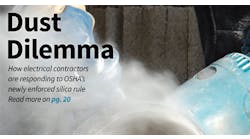There's nothing like the excitement of a new project. You begin with a raw, clean site. You start with a fresh team of players. You're working with new systems and components. You get to experience the excitement of seeing a facility rise from the ground up. That's why I consider new construction the glamorous part of electrical construction and maintenance work.
Maintenance work, on the other hand, can be dull and boring. You're always working on the same systems, checking operation and taking measurements on the same pieces of equipment over and over again. Oftentimes, you find yourself working in dirty, cramped spaces. There's definitely no glamour in this line of work — that is, unless something breaks or goes offline at the most inopportune time. At that point, you'll inevitably find yourself on center stage, which we all know can be good and bad.
Maybe that's why the number of electrical maintenance specialists employed in industrial and commercial facilities continues to dwindle. The work is just too mundane and lacks the excitement of new construction. Or maybe today's maintenance professional just doesn't want the added pressure of finding himself at the center of attention when something shuts down in our new “no-downtime” world. Or could it possibly be due to some other factors like the closure of manufacturing plants all across the country or the continued trend of cutting staffing levels at those plants that remain in service. Sound a little more realistic?
It's no secret that the maintenance world was forever changed when everyone jumped on the outsourcing bandwagon some years ago. Facility executives knew the quickest way to reduce operating costs was to reduce payroll, and maintenance teams paid the price. Why have a staff a five or six sitting around when one person could handle the urgent day-to-day issues with little or no problem? Their thinking was they could always bring in temporary help whenever they needed to expand the system. The harsh reality was they were right.
But did this approach really save them the dollars they thought it would? I'm not so sure. Although they no longer had to pay salaries or provide benefits to full-time employees, they were also forced to pay experts to come in and do anything out of the ordinary — that is if you can find them and they're available when you need them. In addition, the existing management team must also devote extra time, money, and manpower to managing contracts, coordinating safety plans and procedures, and overseeing the work of these outside workers. Don't kid yourself: Poor coordination of outside service crews can lead to inefficiency and higher costs just as easily as they can with in-house staff. Speaking of costs, let's not forget about the cost of business. Hiring outside expertise isn't cheap. These companies have to not only carry the overhead costs for their employees, but also make a profit on the work they're performing for you too. You tell me how this ends up being cheaper than employing your own maintenance crew.
One thing is for sure, if you're still involved with maintenance at a plant or facility, you better figure out how best to manage or work alongside your outsourcing counterparts (see this month's Cover Story on page 34). It's also a good idea to stay on top of the latest equipment assessment technologies (see Maintenance Facts on page 20) and software packages (see CMMS article on page 42) that can streamline and predict potential problem areas in your plant. If you don't, you'll soon realize the true cost of maintenance.


